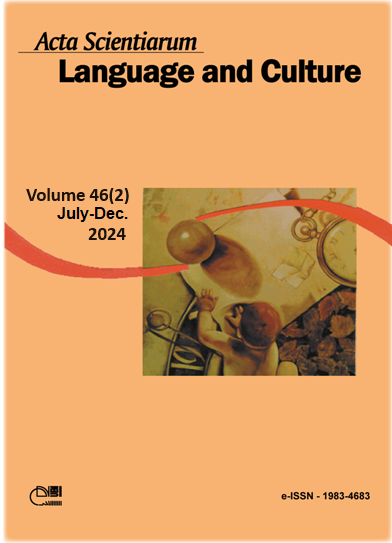The great Gatsby in Baz Luhrmann’s cinema: a reading of the adaptation of the homonymous novel on the American dream
uma leitura da adaptação do romance homônimo
Abstract
This study aims to conduct an analysis of the film adaptation of ‘The great Gatsby’, a novel by F. Scott Fitzgerald, directed by Baz Luhrmann in 2013 and starring Leonardo DiCaprio. The analysis is grounded in theories of adaptation, intertextuality, and comparative literature. The objective is to explore how the film translates and interprets Fitzgerald's novel, a landmark in American literature and an iconic portrayal of the 1920s, known for its unrestrained materialism, glamour, and questionable morality. The novel, released in 1925, was not immediately acclaimed as a masterpiece, despite its focus on the “crazy years” following World War I. ‘The great Gatsby’ is famous for its critique of the era's materialistic excess, something that Luhrmann seeks to capture visually and thematically in his adaptation. The film, with its extravagant use of lights, colors, and sounds, reflects the opulent lifestyle and moral decay of the era while drawing parallels with contemporary society. The research examines the fidelity and liberties taken by Luhrmann in relation to the original text, focusing on how elements such as Nick Carraway's narrative and the symbolic representation of the American dream are adapted for cinema. Luhrmann's stylistic choices, including the use of 3D, and how these dialogue with the interpretation of the novel, are also analyzed. The results indicate that Luhrmann's adaptation offers a unique perspective on the novel, highlighting its central themes while introducing new layers of interpretation. The analysis underscores the complexity of film adaptation as a creative process that, although based on a pre-existing literary work, results in an autonomous artistic creation, with its own qualities and meanings. The study highlights the importance of understanding film adaptations not as mere translations but as significant reinterpretations that contribute to the dialogue between literature and cinema.
Downloads
References
Referências
Barthes, R. (1974). S/Z. Oxford, UK: Blackwell.
Braga, C. R. V. (2013). A reinterpretação globalizada de Baz Luhrmann para O grande Gatsby, clássico de F. Scott Fitzgerald, de 1925. Revista de Letras, 53(1), 27-48.
Bruls, I. (2015). The Representation of the american dream in film adaptations of The great Gatsby (Tese de Bacharelado). Utrecht University, Utrecht.
Chartier, R. (1999). A aventura do livro: do leitor ao navegador. São Paulo, SP: Editora UNESP.
Compagnon, A. (1999). O demônio da teoria: literatura e senso comum. Belo Horizonte, MG: Editora UFMG.
Corrigan, J. (2010). The 1920s decade in photos: the roaring twenties. Berkeley Heights, NJ: Enslow Publishers.
Edgar-Hunt, R., Marland, J., & Rawle, S. (2010). The language of film. La Vergne, TN: AVA Publishing.
Faria, G. (2019). Literatura e cinema. In G. Faria, Estudos de literatura comparada (p. 175-189). Curitiba, PR: Appris.
Ferreira, M. A. C. (2016). Entre o Gatsby de Fitzgerald e o de Luhrmann: um estudo sobre adaptação cinematográfica (Monografia de Graduação). Universidade Estadual da Paraíba, Campina Grande.
Fitzgerald, F. S. (2011). O grande Gatsby. São Paulo, SP: Penguin Classics Companhia das Letras.
Gomes, A. S. (2009). Literatura norte-americana. Curitiba, PR: IESDE.
Grissom, C. U. (2014). Fitzgerald and Hemingway on film: a critical study of the adaptations, 1924–2013. Jefferson, MO: McFarland & Company.
Hodo, Z. (2017). The failure of the american dream in ‘The great Gatsby’- Fitzgerald. European Journal of Multidisciplinary Studies, 2(7), 299-305. DOI: https://doi.org/10.26417/ejms.v6i2.p299-305
Hutcheon, L. (2011). Uma teoria da adaptação. Florianópolis, SC: Editora da UFSC.
Johnson, R. (2003). Literatura e cinema, diálogo e recriação: o caso de Vidas secas. In T. Pellegrini (Ed.), Literatura, cinema e televisão (p. 37-59). São Paulo, SP: Editora Senac.
Laera, M. (2014). Introduction: Return, rewrite, repeat: the theatricality of adaptation. In M. Laera (Ed.), Theatre and adaptation: return, rewrite, repeat (p. 1-17). London, UK: Bloomsbury.
Leitch, T. M. (2007). Film adaptation and its discontents: from Gone with the Wind to The Passion of the Christ. Baltimore, MD: The Johns Hopkins University Press.
Luhrmann, B. (Diretor). (2001). Moulin Rouge!. [Filme]. Estados Unidos: 20th Century Fox.
Luhrmann, B. (Diretor). (1996). Romeo + Juliet. [Filme]. Estados Unidos: 20th Century Fox.
Luhrmann, B. (Diretor). (2013). The great Gatsby [Filme]. Estados Unidos: Warner Bros. Pictures.
Mathews, G. (2021). Reflections of Jay Gatsby, the invisible psychoanalytical hero: an exploration of Freudian psychoanalysis in Fitzgerald’s The great Gatsby. International Journal of Current Advanced Research, 10(2), 23894-23896. DOI: https://doi.org/10.24327/ijcar.2021.23896.4735
Melo; F. P., & Kobs, V. D. (2015). A identidade cultural nas adaptações cinematográficas de ‘O Grande Gatsby’. Caderno PAIC, 16(1), 421-434.
Nitrini, S. (2010). Literatura comparada: história, teoria, crítica. São Paulo, SP: EDUSP.
Perrone-Moisés, L. (1990). Literatura comparada, intertexto e antropofagia. In L. Perrone-Moisés, Flores da escrivaninha (p. 91-99). São Paulo, SP: Companhia das Letras.
Ruland, R., & Bradbury, M. (2016). From puritanism to postmodernism: a history of american literature. New York, NY: Routledge.
Silva, T. M. G. (2012). Reflexões sobre adaptação cinematográfica de uma obra literária. Anuário de Literatura, 17(2), 181-201. DOI: https://doi.org/10.5007/2175-7917.2012v17n2p181
Sitepu, Y. Y. B. (2019). Ethical hedonism in F. Scott Fitzgerald’s the great Gatsby. KnE Social Sciences, 3(19), 851-856. DOI: https://doi.org/10.18502/kss.v3i19.4910
Tredell, N. (2007). Fitzgerald's The great Gatsby: a reader's guide. London, UK: Bloomsbury.
Viscardi, R. F. (2016). The american dream in Baz Luhrmann’s great Gatsby. In N. Von Rosk (Ed.), Looking back at the Jazz Age: new essays on the literature and legacy of an iconic decade (p. 179-200). Cambridge, UK: Cambridge Scholar Publishing.
DECLARATION OF ORIGINALITY AND COPYRIGHTS
I Declare that current article is original and has not been submitted for publication, in part or in whole, to any other national or international journal.
The copyrights belong exclusively to the authors. Published content is licensed under Creative Commons Attribution 4.0 (CC BY 4.0) guidelines, which allows sharing (copy and distribution of the material in any medium or format) and adaptation (remix, transform, and build upon the material) for any purpose, even commercially, under the terms of attribution.
Read this link for further information on how to use CC BY 4.0 properly.




















6.png)









